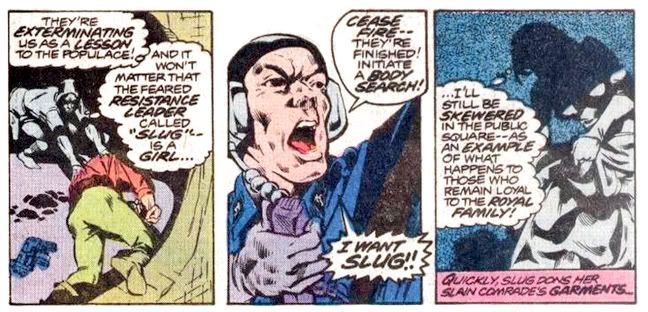
In writing Marvel's Micronauts series, Bill Mantlo took a toy line with no narrative and gave it one, set in a sub-atomic universe filled with all sorts of settings and characters. As the toys touted their "interchangeability," so too did Mantlo assemble the comic out of various parts-- a little Flash Gordon, some Kirby Fourth World, a bit of Star Wars (which I think is obvious and certainly no crime, though Mantlo denied it forcefully in a letter page response to a reader who pointed it out-- to be fair, let's just say Mantlo and Lucas drew from the same source material). To this rich mix he added some cool flourishes that give Micronauts its own identity. Acroyear, for example, was merely the name of two of the toy bad guys, but Mantlo created an entire race of honorable warrior Acroyear, led by a noble outcast who became a major player on the Micronauts team. This innovation came a few years before Star Trek: The Next Generation reconfigured the Klingons from crudely-motivated space cossacks into a clan-and-honor-based culture drawing from Japanese martial tradition. Mantlo also came up with a lot of interesting little supporting characters, too—characters like rebel leader Slug.
Slug. Not her real name, yet not exactly a nickname. A nom de guerre, if you will, but more than that. Slug debuts in the story "A Hunting We Will Go" from the second issue I bought fresh off the spinner rack, Micronauts #4 (April 1979). The book features splendid art by Michael Golden and Josef Rubinstein and I can't figure out why this team wasn't used on Marvel's Star Wars title. Right from the splash they delight readers with high-tech vehicles, a chaotic firefight and lots of everyday type slobs caught in the middle as minor villain Major D'Ark commands an assault on "Sector 7" of Homeworld, the comic's main planet (other than earth, of course). Dodging lasersonics, laser bolts or beams or blaster shots or whatever, Slug jumps into a hole in the wall and changes clothes with a dead man for no apparent reason. After all, it's not as if the rebels wear uniforms or that she wouldn't tip off the bad guys with her defiant eye-squint among a bunch of stunned, gape-mouthed goobers. Somehow this clothes-swap makes someone known only by name and reputation completely anonymous. From there she goes to the worst possible place on Homeworld. By design.
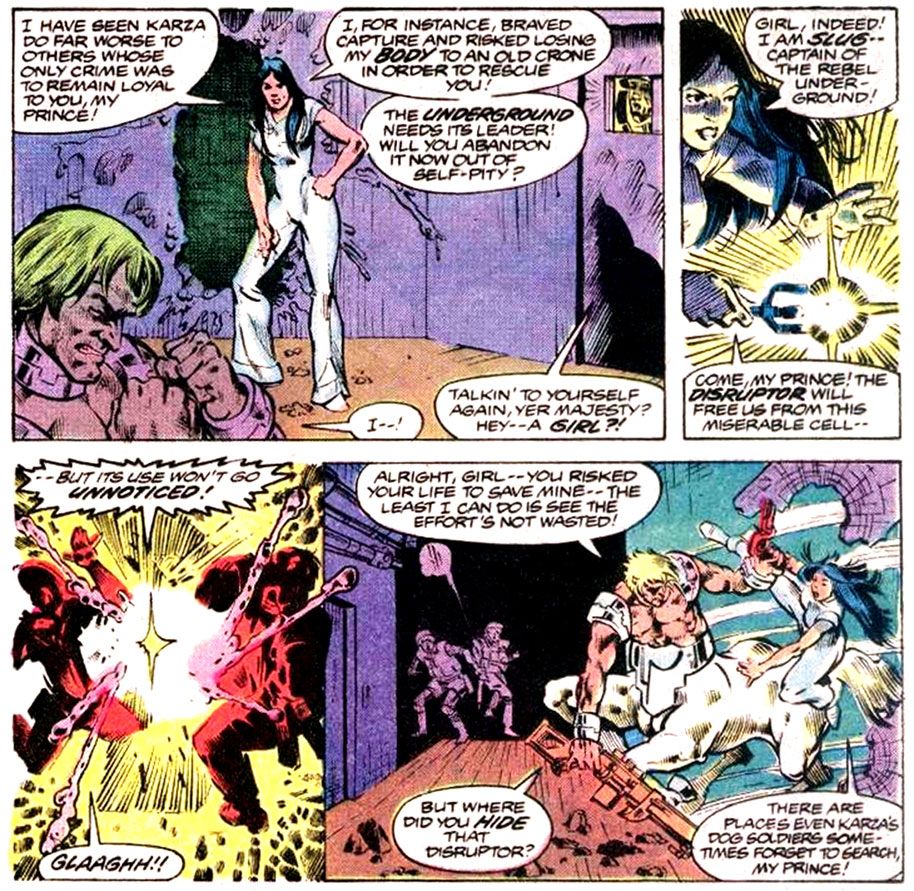 Where did this woman come from? In her brief, violent life, we don't learn a whole lot about her or her motivations, and precious little biography. Mantlo wouldn’t even reveal the story behind her humble handle for another three years, in Micronauts #48 (December 1982). This is when we learn doomed, defiant Slug was born to a prisoner of Baron Karza, the science-mad dictator of the Microverse. She became Slug via one of Karza’s offhand insults as soldiers drag her mother away. With whatever name her parents gave her left unsaid, it's Slug she remains for the rest of her life. The only question is, who told her she was a Slug?
Where did this woman come from? In her brief, violent life, we don't learn a whole lot about her or her motivations, and precious little biography. Mantlo wouldn’t even reveal the story behind her humble handle for another three years, in Micronauts #48 (December 1982). This is when we learn doomed, defiant Slug was born to a prisoner of Baron Karza, the science-mad dictator of the Microverse. She became Slug via one of Karza’s offhand insults as soldiers drag her mother away. With whatever name her parents gave her left unsaid, it's Slug she remains for the rest of her life. The only question is, who told her she was a Slug?Because she's a secondary character rather than main cast, Mantlo never fills us in on what Slug does between birth and rebellion. This means we're free to imagine the hardscrabble life Slug must have lived from that day. Homeworld hosts a hierarchical society with Karza on top, followed by the wealthy elite who support his tyranny. At the bottom, the poor, mostly used by Karza as a recruiting pool for his Dog Soldier armies or for experiments in his Body Banks, the genetic madhouse where Karza dissects and maims at will. It's obviously a dehumanizing system. An orphan among its lowest class, Slug probably learned to steal and hide at first, and later to fight.
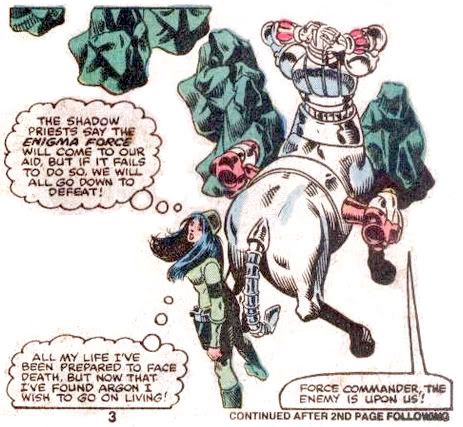 Emphasis on the fighting, because when she first appears Slug is already the semi-legendary leader of the anti-Karza rebellion, no doubt using her street smarts and toughness to plan and survive running street battles with the Dog Soldiers—until she allows herself to be captured. Locked away inside the Body Banks herself, Slug faces the potential horror of having her body taken from her and given to a loyalist. But before that can happen, she uses an energy weapon (I don’t even care to speculate where she hid it, because in on scene she’s forced to disrobe completely in front of Karza’s men) and breaks into the cell of Prince Argon, who’s already suffered the indignity of having his upper body surgically grafted to his horse’s lower body. You know it could’ve been worse: if Karza had more of a sense of humor, he might have done it the other way around. I would have. Look into your heart and you may find you would have, too. Since he didn't, we're free to imagine somewhere in the unseen sections of the Body Banks, there's a horse head running around on human legs.
Emphasis on the fighting, because when she first appears Slug is already the semi-legendary leader of the anti-Karza rebellion, no doubt using her street smarts and toughness to plan and survive running street battles with the Dog Soldiers—until she allows herself to be captured. Locked away inside the Body Banks herself, Slug faces the potential horror of having her body taken from her and given to a loyalist. But before that can happen, she uses an energy weapon (I don’t even care to speculate where she hid it, because in on scene she’s forced to disrobe completely in front of Karza’s men) and breaks into the cell of Prince Argon, who’s already suffered the indignity of having his upper body surgically grafted to his horse’s lower body. You know it could’ve been worse: if Karza had more of a sense of humor, he might have done it the other way around. I would have. Look into your heart and you may find you would have, too. Since he didn't, we're free to imagine somewhere in the unseen sections of the Body Banks, there's a horse head running around on human legs.Flights of horse-ass based fantasy aside, Slug quickly convinces the despairing Argon to fight for his life and they blast their way out of the Body Banks. With Slug riding on Argon’s back. Which is pretty sensible, when you think about it. After all, it is a horse's body which means it has horse's legs. Strong and fast enough for both Slug and Argon to make good their escape.
After that, Slug doesn’t contribute a whole lot to the fight against Karza, at least not on-panel. But when Mantlo and Golden do depict Slug in action, it’s to gun down some rich jerks who won’t join the rebellion. That’s pretty hardcore. Che Girlvera.
This happens in Micronauts #7 (July 1979). Yes, Argon, what a queen Slug would make. The queen of summary executions.
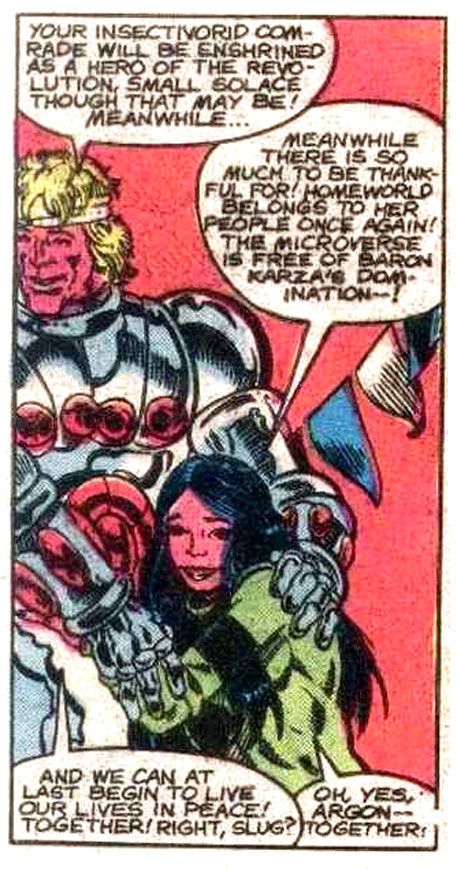 Fighting for freedom side-by-side (the freedom to be ruled by a king instead of a baron), the two fall madly in love. Under Slug's influence, Argon dons King Dallan’s holy armor, which looks like the negative version of Karza’s unholy armor. Despite being something of a dumbass as it turns out, Argon takes charge of the rebellion, no doubt coached at every turn by the more-capable Slug. At least I hope that's the subtext Mantlo intends as he relegates Slug to a more supporting role in the conflict. But despite lacking Slug's brains, Argon does have four hooves and a couple of rockets on his back, and so proves himself every bit as gutsy as his girlfriend.
Fighting for freedom side-by-side (the freedom to be ruled by a king instead of a baron), the two fall madly in love. Under Slug's influence, Argon dons King Dallan’s holy armor, which looks like the negative version of Karza’s unholy armor. Despite being something of a dumbass as it turns out, Argon takes charge of the rebellion, no doubt coached at every turn by the more-capable Slug. At least I hope that's the subtext Mantlo intends as he relegates Slug to a more supporting role in the conflict. But despite lacking Slug's brains, Argon does have four hooves and a couple of rockets on his back, and so proves himself every bit as gutsy as his girlfriend.By Micronauts #12 (December 1979), with the war against Karza apparently finished, Slug prepares to hang up her guns and start exploring the softer side of life. The very same young woman who once blew the upper class away with a laser-blaster coquettishly melts into the arms of the heir apparent. You can’t help but think Slug feels a little pang of guilt when Argon asks her in #13 (January 1980) if she’s ready to trade rebellion for royalty. Or not. Her politics are more than a little odd when you consider her rebellion wasn't a democratic one by any means. It was more of a pro-monarchist insurrection. She fought to replace an autocratic regime with an aristocratic one, not to give the people a voice in their government, unless revolution counts as a voice. Now that I think it over, I'm sure it does. I prefer elections to violence, however, but with a monster like Karza in charge, Slug and her fellow rebels didn't have that choice. Whatever her former beliefs, Slug seems happy to hint at a new role for herself. She's to marry into royalty as her reward.
Life afterwards doesn't go as smoothly as Slug might have hoped, despite being drawn for a few issues by Howard Chaykin, with inks by series editor Al Milgrom. Chaykin was penciller on Marvel's Star Wars movie adaptation, so he might have seemed a natural fit for Micronauts, just as Golden would have been for that other property. Unfortunately, Milgrom's inks are far from sympathetic and give the book a rushed look. Which it may very well have been-- Micronauts features a lot of complex machinery and a massive cast so it must have been a chore for art teams to meet deadlines. And even when matched with ideal material, Chaykin never had much luck with inkers at Marvel. He fared much better doing his own finishes in his American Flagg series at First Comics.
Possibly as disappointed by the art as I was at the time, Slug slinks away until Micronauts #22 (October 1980), and when she reappears, she's still a fiesty one. And more than a little strident, a trait she hadn't evidenced before despite having been a fine leader. Guess success does that to a person. New artist Pat Broderick with his Michael Golden-esque style has Slug ditch her tomboyish green fez and functional pantsuit look for space lingerie and strands of pearls in her hair.
This choice seems a little off given Slug's rough-and-tumble origins, but as a character look it has precedents. Maybe it's because of Dejah Thoris, Edgar Rice Burroughs's original space queen. From what I understand, Martians of her tribe generally run around naked but for some jewelry (they think clothes are weird, which, from a quick Google search for new Dejah Thoris comics, proves convenient for today's comic book artists whose only exposure to female anatomy seems to have come from porn magazines). Alex Raymond contributed Princess Aura and Queen Azura. They're pretty modest by Barsoomian standards but like leisure Slug, they favor mid-drift exposure in jeweled bras and diaphanous skirts. No doubt directly inspired by those two creations, Al Williamson and Wally Wood favored this look for their female characters in various EC titles. Broderick's Slug is very much drawn in this tradition.
While we're on the topic of costumes, I'm going to challenge artists of our next generation of space princesses and guerilla-girls-turned-space-princesses to draw some inspiration from the Renaissance, or even the Baroque or Rococo periods. Not because I'm against skin (check out some Francois Boucher paintings), but because this kind of finery has regality and offers ample opportunities for sumptuous drawings of lace and folds and printed patterns, plus differing fabric textures. Your Dejahs and Auras are fine and dandy, but my image of the ideal space princess is Virginia Madsen as Irulan in David Lynch's 1984 adaptation of Dune. We just don't see this kind of thing often enough, but we have plenty barbarian-queens-in-silk-or-metal-bikinis imagery.
And whatever Slug's new fashion sense, it doesn't prevent her from finding a world of trouble. Argon abruptly kidnaps her to Aegypta, a desert-like zone of Homeworld-- more Flash Gordon influence; Homeworld is made up of different zones each with its own distinct ecosystem, much like Mongo-- where men are men and women are women and everyone rides green ostriches. There she's rescued by Pharoid, the leader of the ostrich-riders. Like Argon before him, Pharoid falls madly in love with Slug but unlike his romantic rival, he spends the rest of his days trying to prove worthy of her.
But why does Slug's fiance drag her against her will into the desert in the first place? Well, it has to do with the nature of mainstream comics where a good villain can never stay dead and a popular story has to repeat itself. Even with an entire micro-galaxy possibly full of all kinds of heretofore never-seen-in-comics stories to explore, the Micronauts still end up fighting massive space wars against Karza, twice after he's possessed or otherwise transformed poor, stupid Argon.
The first plot redux renders Argon the mindless slave under the influence of Karza's mind control. After Mantlo thoroughly sets the stage for it, Argon jumps into a live volcano and comes out transformed into the arch-villain. Once again it's our heroes against Karza, and Slug does her part largely off-panel. The main fighting takes place in a pseudo-Disneyland between the forces of Karza and those of SHIELD, led by good ol' Nick Fury.
Actually, after her kidnapping, Slug's major contribution to the war is to stand by Prince Argon at the mass funerals that conclude the storyline. Given the circumstances, they make an appropriately downbeat pair, but at least Argon has his human legs back.
The next time Karza rears his ugly mind, Slug watches as her beloved dimwitted Argon lowly goes insane, first bringing back the Dog Soldiers as his personal guard in Micronauts #34 (October 1981) and then declaring his rule absolute. To have your Argon transform into Baron Karza once is unfortunate; twice smacks of carelessness. As for Slug, she finally starts to rethink her commitment to a man who can't decide who he is today-- nice king in white or totally different guy in black. When Argon dons Karza's armor and declares the Micronauts outlaws while ranting and raving like a loony, Slug has had enough. Now riding her very own green desert ostrich, she attacks her fiance, only to have Pharoid jump in and reduce her to an observer. At this point it's been quite a while since Slug actually did much of anything, but this desultory attempt at reclaiming her "action girl" is her next-to-last attempt at reclaiming agency. And she does so while wearing her pearls and bra look again. Does she own only the one outfit?
You probably wonder yourself what kept Slug attached to the increasingly pathetic Argon for so long. Perhaps it's the chance to have herself drawn by the legendary Gil Kane, who takes up the pencils with Micronauts #40 (April 1982), inked by Danny Bulanadi, who transforms him into a pseudo-Broderick.
With his slick feathered modeling and heavy black-spotting, the stalwart Bulanadi provided visual continuity on a book that must have been hell on pencillers to judge by the turnover on art. In those days, pencillers usually didn't do the tight rendering they do now and it was up to inkers to finish the art and make things look more or less the same from issue to issue. Bulanadi was a master at this-- Val Mayerik breakdowns, a short run of Keith Pollard pencils, even a single issue by as unique a stylist as Steve Ditko look almost identical apart from differing approaches to page layouts and character dynamics. Along came Kane, who was born for this book despite having a more linear approach and a surer hand with the storytelling than either Golden or Broderick. Bulanadi knocks himself out on the finishes, but we lose a lot that's essentially Gil Kane.
Maybe longtime readers would have balked at such a radical departure on the interiors, but at least Kane was able to ink his own covers. Eventually, the massive workload of Micronauts ground down Kane, who switched to supplying only breakdowns, with Bulanadi maintaining the book's look. I don't know about you, but those pure Kane covers make my mouth water for something more characteristic of his work.
In the end, Argon has Slug's soul switched into the body of Lady Belladonna, a dessicated old poop and Karza loyalist. The plan is for Argon to wed Belladonna in Slug's body and not tell the people of Homeworld. That way they'll see that no matter how much of a tyrant he becomes, at least one of the great anti-tyrants of our time loves him enough to marry him. That's suppose to shut up any protests. Here at the bitter end of her career as rebel and royal, Slug gets a few panels hobbling around with a gun. Then the body-switched women team up to infiltrate the Body Banks in a desperate bid to fix themselves, but it's too little, too late for Slug. She's been reduced to complete ineffectuality.
In Micronauts #49 (January 1983), as pencilled this time by Jackson "Butch" Guice, Argon literally rips himself in half and out steps a fully-formed Karza, which should have surprised no one. Well, the tearing himself in half might have been a shocker, but the re-emergence of Karza wouldn't have been for anyone with a brain. In the rain, while everyone engages in a massive comic book fist fight, Belladonna's aged body simply gives out from the strain with Slug still inside it and then Karza throws her younger form against a wall, breaking its neck and killing Belladonna as well. That happens in Micronauts #50 (February 1983). The series went on for another two years, but among the various deaths and resurrections, there's nothing remaining for a character introduced with a bang and disposed of with a whimper. Poor Slug.
The Microverse is kind of a dark place, isn't it? Makes Macbeth seem sort of cheerful by comparison. Characters die all the time, heroic Commander Rann suffers all kinds of torments and loses his hand, Karza commits genocide on a planetwide scale. So maybe it's thematically fitting Slug's infancy was so harsh, her life full of conflict and tragedy, her attempts at fighting for life and freedom abortive, her death abrupt and anti-climactic.

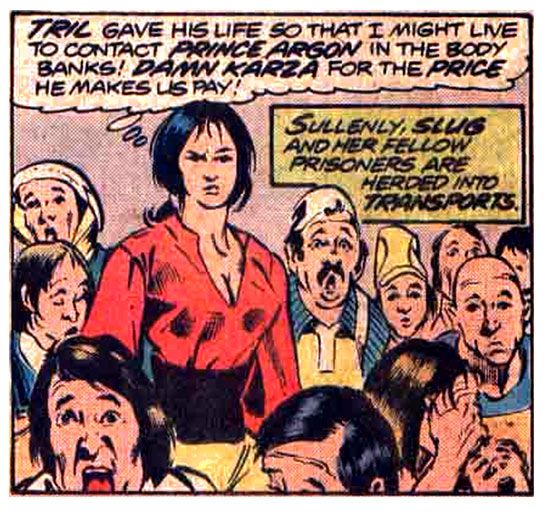
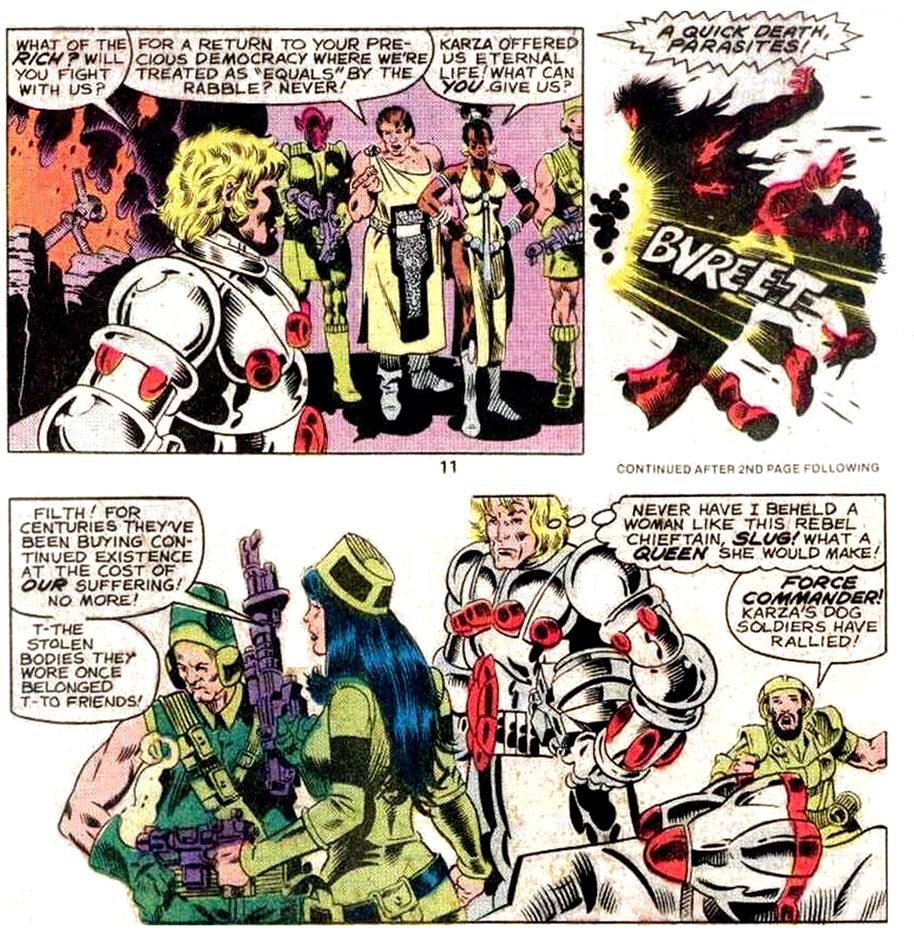
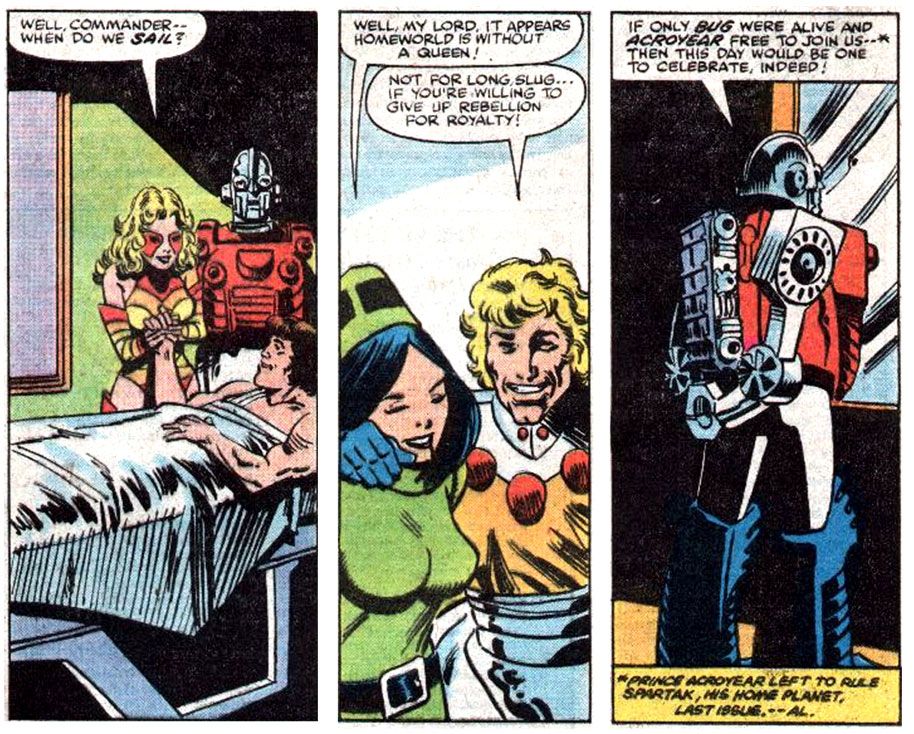
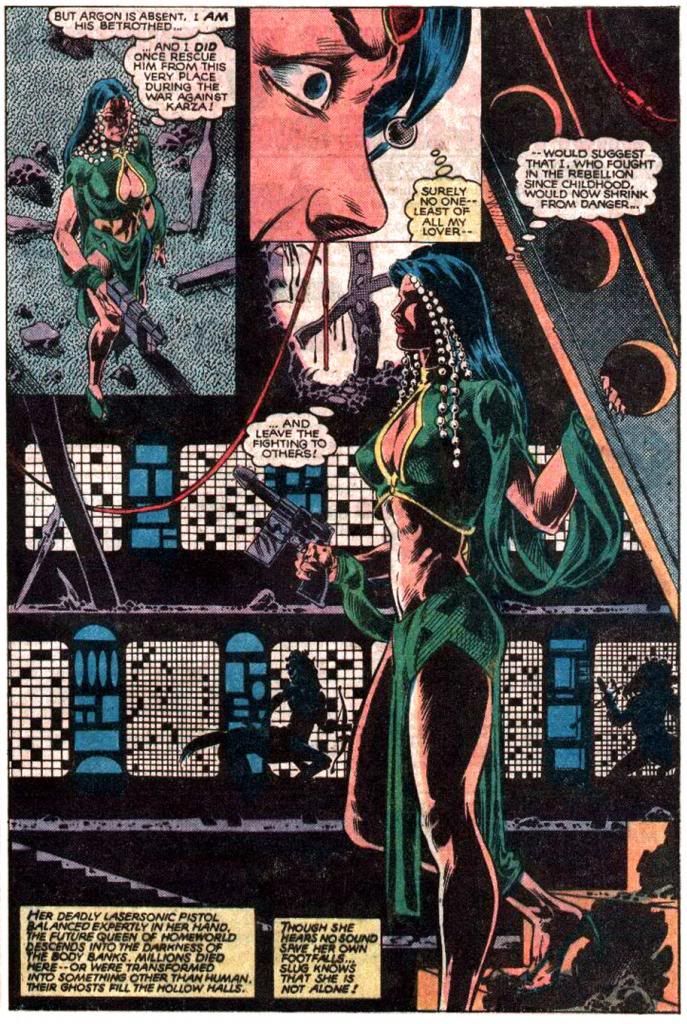
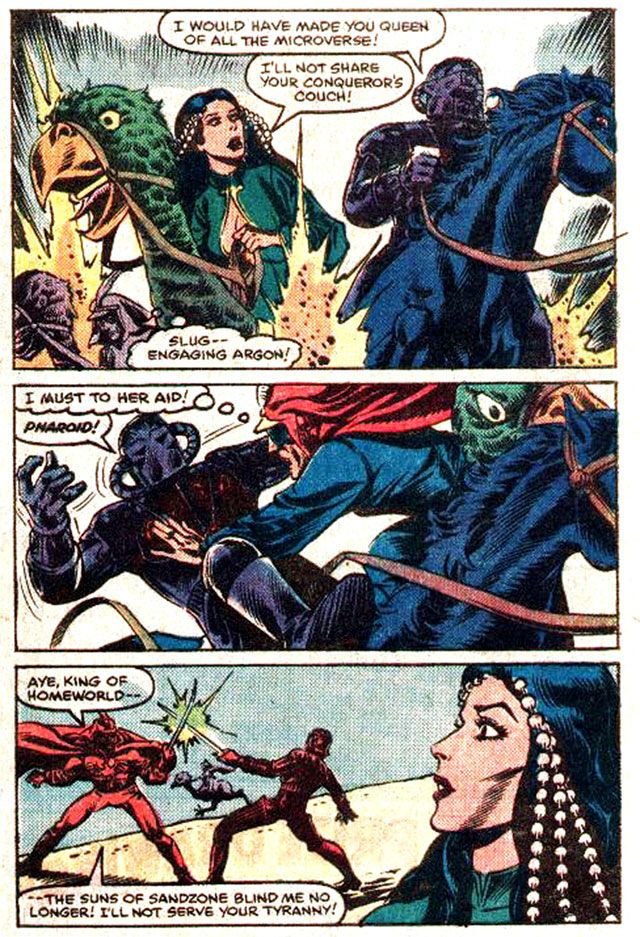
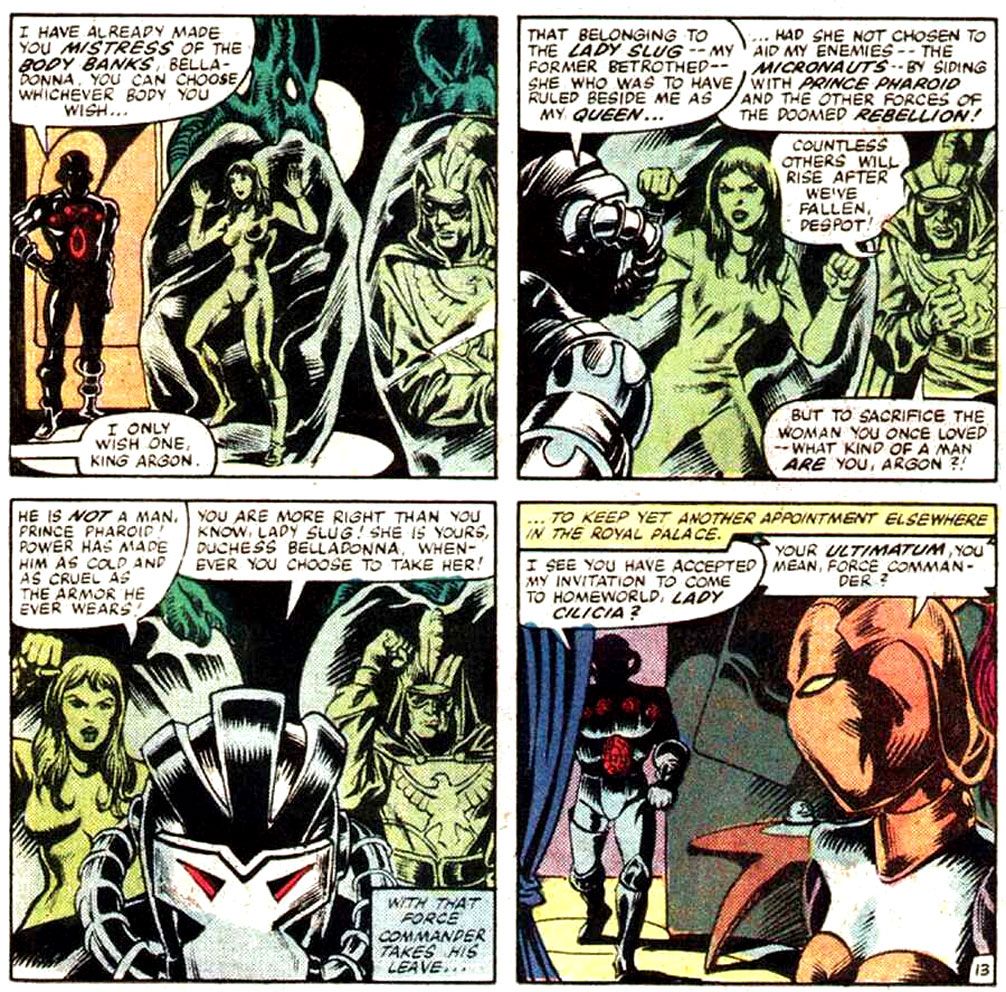
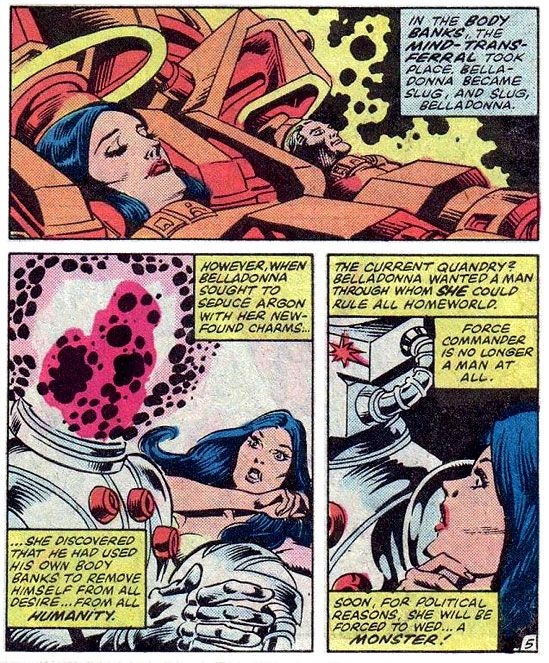

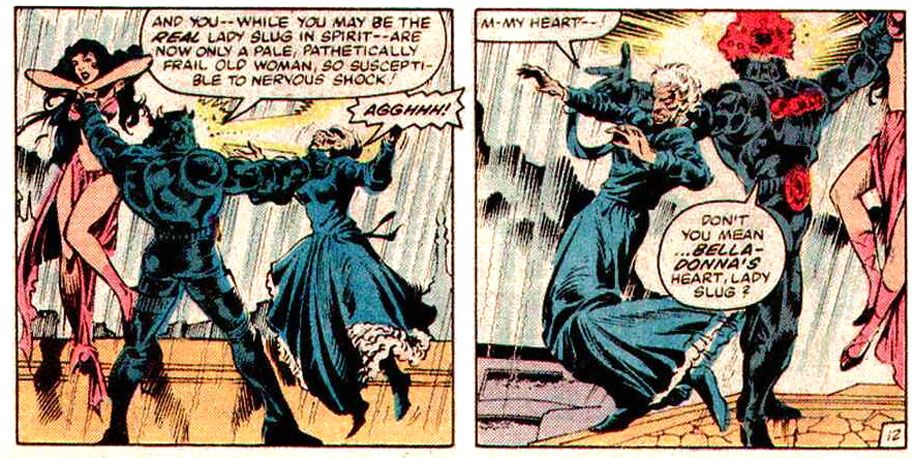
No comments:
Post a Comment